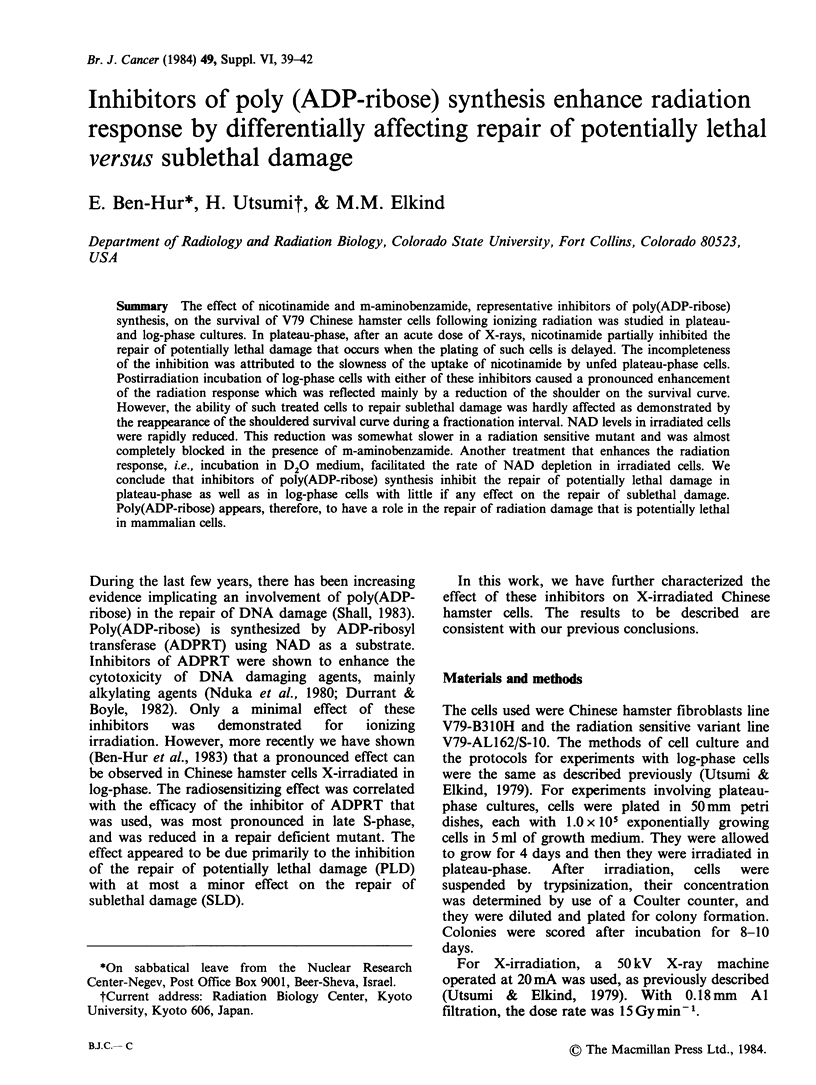Abstract
The effect of nicotinamide and m-aminobenzamide, representative inhibitors of poly(ADP-ribose) synthesis, on the survival of V79 Chinese hamster cells following ionizing radiation was studied in plateau- and log-phase cultures. In plateau-phase, after an acute dose of X-rays, nicotinamide partially inhibited the repair of potentially lethal damage that occurs when the plating of such cells is delayed. The incompleteness of the inhibition was attributed to the slowness of the uptake of nicotinamide by unfed plateau-phase cells. Postirradiation incubation of log-phase cells with either of these inhibitors caused a pronounced enhancement of the radiation response which was reflected mainly by a reduction of the shoulder on the survival curve. However, the ability of such treated cells to repair sublethal damage was hardly affected as demonstrated by the reappearance of the shouldered survival curve during a fractionation interval. NAD levels in irradiated cells were rapidly reduced. This reduction was somewhat slower in a radiation sensitive mutant and was almost completely blocked in the presence of m-aminobenzamide. Another treatment that enhances the radiation response, i.e., incubation in D2O medium, facilitated the rate of NAD depletion in irradiated cells. We conclude that inhibitors of poly(ADP-ribose) synthesis inhibit the repair of potentially lethal damage in plateau-phase as well as in log-phase cells with little if any effect on the repair of sublethal damage. Poly(ADP-ribose) appears, therefore, to have a role in the repair of radiation damage that is potentially lethal in mammalian cells.
Full text
PDF



Selected References
These references are in PubMed. This may not be the complete list of references from this article.
- Ben-Hur E., Riklis E. Deuterium oxide enhancement of Chinese hamster cell response to gamma radiation. Radiat Res. 1980 Feb;81(2):224–235. [PubMed] [Google Scholar]
- Ben-Hur E., Utsumi H., Elkind M. M. Potentially lethal and DNA radiation damage: similarities in inhibition of repair by medium containing D2O and by hypertonic buffer. Radiat Res. 1980 Oct;84(1):25–34. [PubMed] [Google Scholar]
- Bernofsky C., Swan M. An improved cycling assay for nicotinamide adenine dinucleotide. Anal Biochem. 1973 Jun;53(2):452–458. doi: 10.1016/0003-2697(73)90094-8. [DOI] [PubMed] [Google Scholar]
- Durkacz B. W., Omidiji O., Gray D. A., Shall S. (ADP-ribose)n participates in DNA excision repair. Nature. 1980 Feb 7;283(5747):593–596. doi: 10.1038/283593a0. [DOI] [PubMed] [Google Scholar]
- Durrant L. G., Boyle J. M. Potentiation of cell killing by inhibitors of poly(ADP-ribose) polymerase in four rodent cell lines exposed to N-methyl-N-nitrosourea or UV light. Chem Biol Interact. 1982 Feb;38(3):325–338. doi: 10.1016/0009-2797(82)90062-x. [DOI] [PubMed] [Google Scholar]
- Hahn G. M., Bagshaw M. A., Evans R. G., Gordon L. F. Repair of potentially lethal lesions in x-irradiated, density-inhibited Chinese hamster cells: metabolic effects and hypoxia. Radiat Res. 1973 Aug;55(2):280–290. [PubMed] [Google Scholar]
- Nduka N., Skidmore C. J., Shall S. The enhancement of cytotoxicity of N-methyl-N-nitrosourea and of gamma-radiation by inhibitors of poly(ADP-ribose) polymerase. Eur J Biochem. 1980 Apr;105(3):525–530. doi: 10.1111/j.1432-1033.1980.tb04528.x. [DOI] [PubMed] [Google Scholar]
- Utsumi H., Elkind M. M. Potentially lethal damage versus sublethal damage: independent repair processes in actively growing Chinese hamster cells. Radiat Res. 1979 Feb;77(2):346–360. [PubMed] [Google Scholar]
- Zwelling L. A., Kerrigan D., Pommier Y. Inhibitors of poly-(adenosine diphosphoribose) synthesis slow the resealing rate of x-ray-induced DNA strand breaks. Biochem Biophys Res Commun. 1982 Feb 11;104(3):897–902. doi: 10.1016/0006-291x(82)91333-x. [DOI] [PubMed] [Google Scholar]


